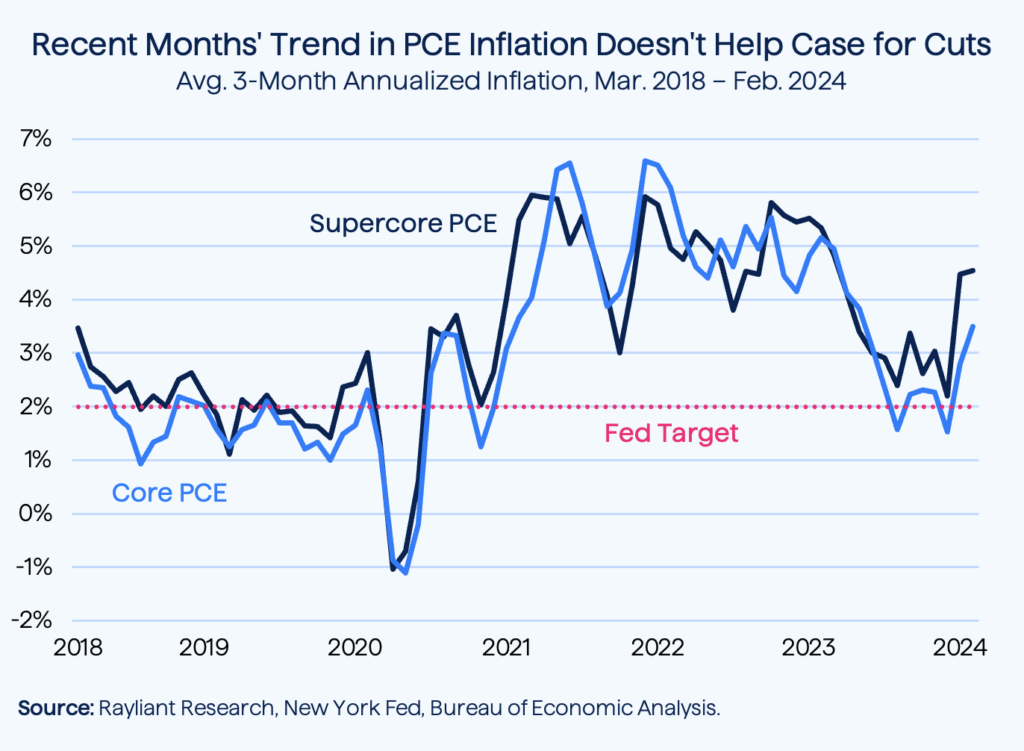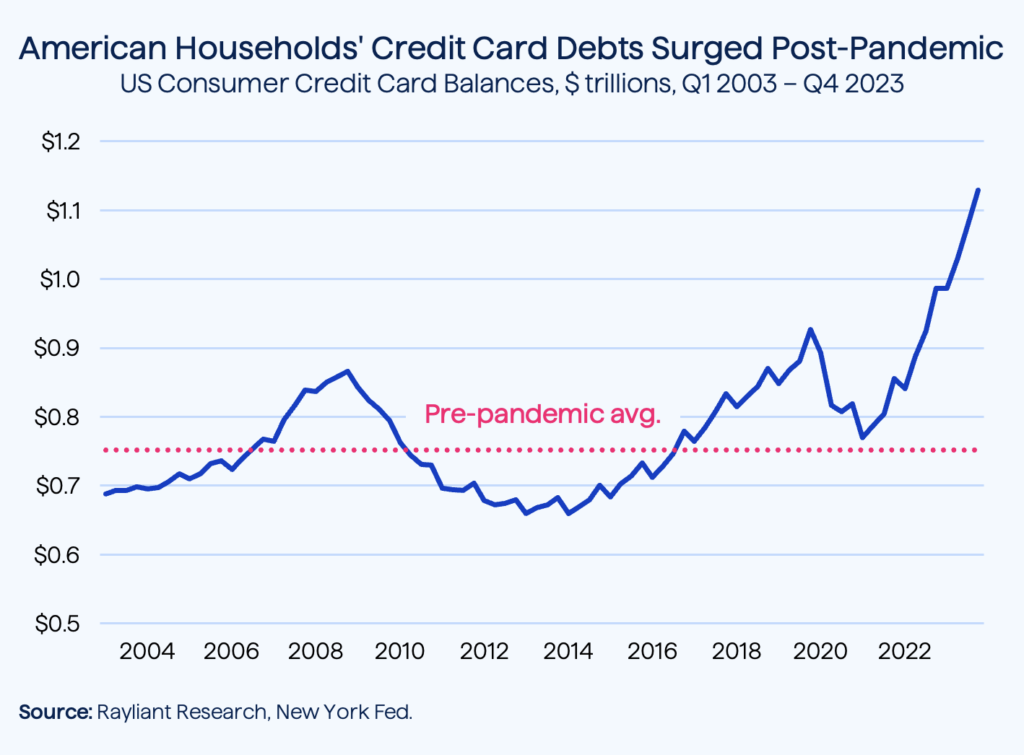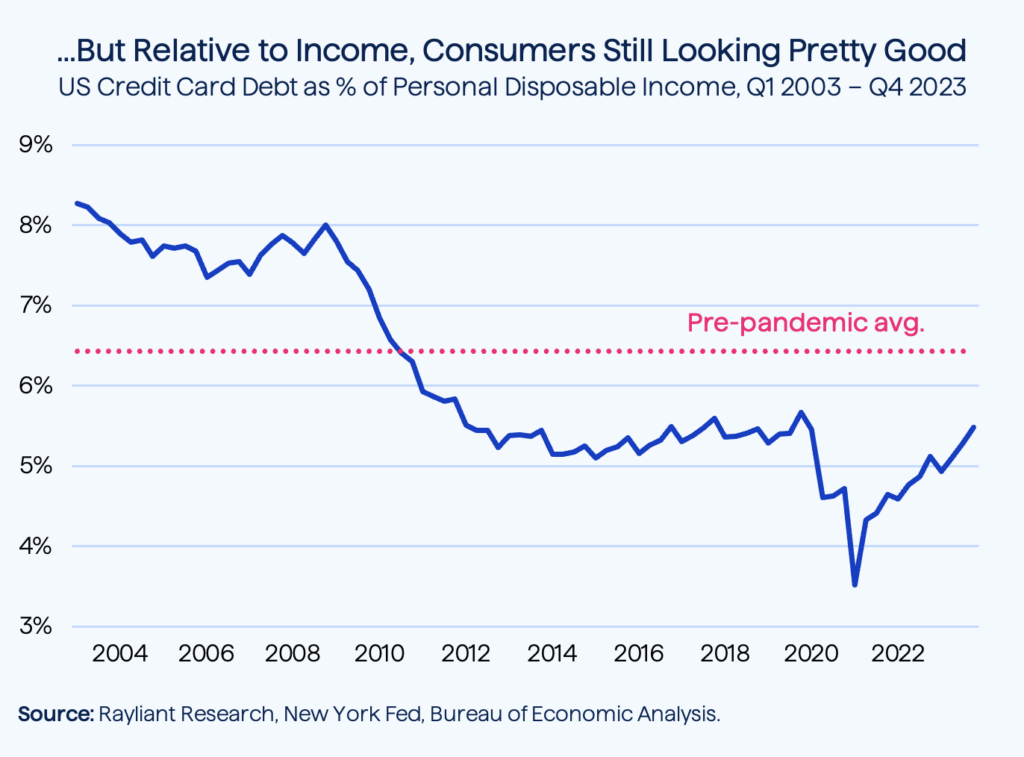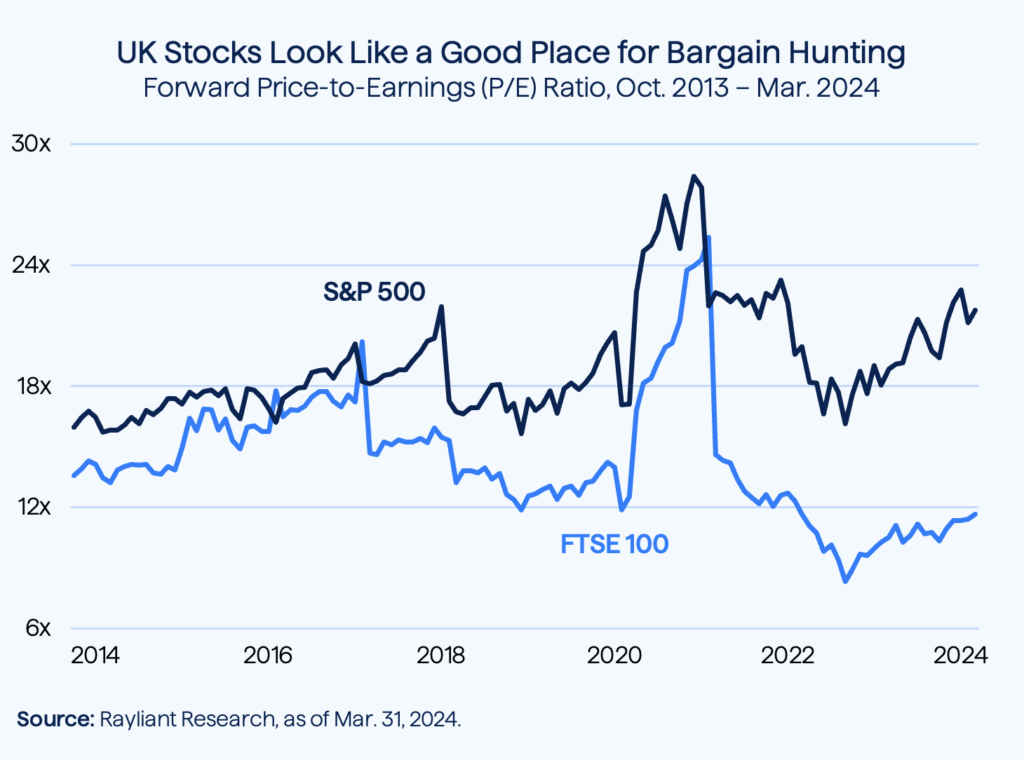
The CIO’s Take: With just a few more big reports on US inflation before the April FOMC, many investors saw last week’s BEA report on personal consumption expenditures (PCE) as a potentially market-moving release. There turned out not to be any bombshells in the data, with year-over-year headline and core PCE inflation spot on economists’ forecasts, though we’re having trouble seeing in any of the last two months’ facts on the ground a strong argument for rushing to cut rates by June. Speaking shortly after the BEA posted its report, Fed chair Powell said as much to bankers at a conference hosted by the San Francisco Fed, coming off a little more cautious to us. Picking up on a somewhat surprising February surge in US consumer spending, we believe an underappreciated risk is that Fed cautiousness takes us far enough for high inflation and restrictive financial conditions to finally catch up with American households. As such, we’re still leaning toward risk being asymmetric to the downside, and remain slightly underweight equities with a focus on stock picking within cheaper markets, like those of the fast-growing emerging economies, or developed markets like Japan and the UK.
Fed’s preferred measure meets forecast
Last Friday, the US Bureau of Economic Analysis (BEA) released the Fed’s favorite inflation gauge, the Personal Consumption Expenditures (PCE) Index. After the last couple months’ CPI came in hot, Friday’s BEA report made for one of the most anticipated economic events of the week, with traders looking for validation that inflation is softening and rate cuts might be on the horizon. Cutting to the chase, we doubt most doves or hawks will find anything in the report definitive. Headline PCE inflation ticked up from 2.4% year-over-year in January to 2.5% in February, a reading that was in line with economists’ consensus forecast. Core PCE inflation, stripping out volatile food and energy prices, fell from 2.9% in January to 2.8% in February, but that was also in line with estimates. The most promising piece of data was probably core services prices excluding energy and housing—so-called “supercore” PCE, considered an indicator of labor costs—which slowed to 0.2% month-over-month in February, down from a brisk 0.7% month-over-month increase in January.
Powell says Fed in no rush to start easing
But even considering that tame supercore reading, it’s hard to look at the last few month’s resurgence in price pressures (see below), and not conclude that the beginning of 2024 represents at least the “bump” Fed chair Jerome Powell mentioned at last month’s FOMC—possibly more. In fact, shortly after the BEA released February’s PCE, we got another glimpse into the Fed’s decision-making when Powell hit the stage at an event put on by the San Francisco Fed. He confirmed precisely what we said above, that the PCE data were “pretty much in line with our expectations,” but also noted that the economy “doesn’t feel like it’s suffering from the current level of rates” and concluded he and his colleagues on the FOMC “don’t need to be in a hurry to cut”. Referring again to the plot below, it’s easy to see why the Fed doesn’t want to rush things. This is what worried us when we cautioned readers at the end of last year not to put too much stock in early-2024 cuts, and why we believe there’s still risk to hopes of easing by June. March inflation data could prove pivotal, with one more PCE report on tap before April’s FOMC.

Consumer spending surges in February
Beyond price data, there was another item in the latest BEA release that caught our eye: real consumer spending, which rose 0.4% month-over-month in February, way ahead of the 0.1% consensus forecast. That boost came from spending on both goods and services, with the latter seeing its biggest increase since July 2021. An 0.8% increase in wages and salaries could help to explain where consumers are finding such confidence—but will do little to assuage concerns over labor market tightness feeding into rising prices. We expect Fed officials digging through the full set of BEA data tables and seeing figures like those just cited will feel better about their decision to delay the first cuts of this cycle. Our concern is that if the data keep trending this way, markets may be disappointed by how late easing comes. Along those lines, we note that just a week prior to Powell’s speech, Raphael Bostic, president of the Atlanta Fed, told reporters he expected just one cut by the end of 2024.
High-interest loans power consumption
Evidence in the PCE data of strong consumer spending was something of a surprise, given weakness in the last couple months’ retail sales data, something about which we had commented in last week’s Perspectives. Interestingly, consumers’ savings tracked by the BEA were seen to dip in February, suggesting households were likely tapping savings to make room for additional consumption. That would jibe with data we’ve been following over the last couple years showing US consumers racking up massive credit card balances (see below), in a bid to keep spending up—despite rates charged on those balances hitting historic highs amidst Fed hikes. Indeed, consumers in 2023 reportedly paid 50% more in credit card expenses than they did in 2020, with interest payments and fees rising by $51 billion to $157 billion per year over that period. Perhaps not surprisingly, as lending expands and rates remain high, credit card delinquencies have been trending up since 2022.

Worry about spending softening, not defaults
So, how big a problem is this? To understand what ballooning credit card balances tell us, it’s useful to gain a little more context. First, we note that analysts typically look at credit card debt as the funding option of “last resort” for consumers. That’s especially true when interest rates charged on those cards are as high as they are now. In the last two years, consumers have made greater recourse to pay with plastic despite those high rates, in part because they’ve been unwilling to change spending habits in the face of tightening financial conditions, but also because of the pressures inflation is putting on households’ budgets. At the same time, if one scales the size of credit card balances by personal disposable income—again pulled from the BEA data—one finds that, given how much more Americans are earning these days, credit card debt is still well short of pre-pandemic levels (see below). And those rising credit card delinquencies we mentioned? They’ve reached their highest level since Spring 2011, to be sure, but are still fairly low relative to long-term averages. As such, we look at Americans’ rising credit card debt as much more a signal that households’ finances are increasingly stretched—perhaps to the point we’ll start to see spending roll over—but not a systemic risk worth worrying about.

Consider seeking better valuations abroad
US investors have been fortunate in recent years that the well-documented “home bias”—by which investors typically allocate too much to equities in their home country—has actually helped them. That’s because US stocks have been among the best performing in the world. Consider the AI rally: with a few exceptions, it’s largely been a US phenomenon so far. Now many investors are looking at the prospect of rate cuts by the US Federal Reserve and wondering whether easing could be the catalyst to drive America’s markets to more exceptional returns in the years ahead. On the flipside, as we’ve often remarked, all of that “looking ahead” should be impounded into prices, such that today’s lofty US valuations already assume plenty of good news in store for US stocks. One answer to the risk of expectations for a broad market like the US being too rosy is to actively pick and choose among US stocks. That’s something we’ve advocated before. Another solution is to look internationally, to markets where the average stock looks less expensive.
Record spread between US and UK stocks
So which markets might we have in mind? We’ve talked at length about the opportunities we see for stock pickers in emerging markets, including China. We’ve also commented on Japan’s market, which notwithstanding a record-breaking rally over the last year, we think still trades at pretty juicy valuations. But there’s a developed market a bit closer to home that we’d like to highlight as particularly cheap: equities in the United Kingdom. That home bias we mentioned before has been much harder on UK investors—at least, the ones without good advice on international diversification!—since the beginning of 2020, as the FTSE 100 Index has underperformed the S&P 500 by a whopping 9.2% per year. But a big chunk of that underperformance has come from divergence in valuations between the two markets (see below), with the UK trading at a record discount to the US in 2024.

Smart stock picking, not a blanket country tilt
Consistent with that difference in valuations, there’s been a notable lack of investor enthusiasm for UK stocks, with the average institutional asset manager underweight UK stocks by over 25% according to a recent survey by Bank of America. Of course, part of the difference in valuations is dictated by the types of companies that list in each market, with UK stocks tending toward defensive names in the energy, financials, and consumer staples sectors; the UK economy also finds itself in a much tougher spot than that of its American cousins, with the same persistent inflation—likely to keep rates high for some time still—but also dramatically lower growth. As such, our call is less about tactically tilting one’s portfolio toward UK’s broad market, but rather a suggestion that for active stock pickers, there may be some interesting under-the-radar plays among sleepy UK stocks dragged down by historically weak relative sentiment. It never hurts to start one’s fishing for bargain stocks within a more promising pool.
You are now leaving Rayliant.com
The following link may contain information concerning investments, products or other information.
PROCEED